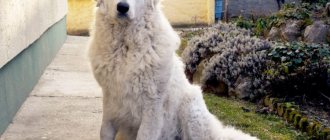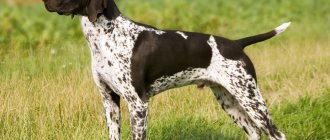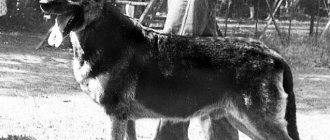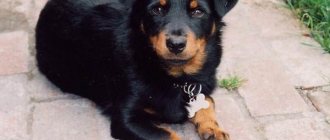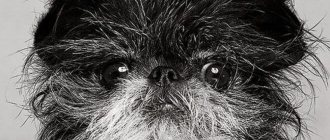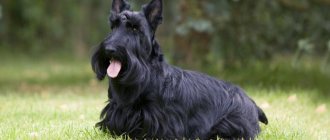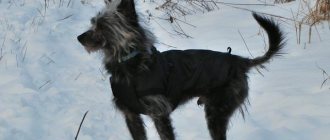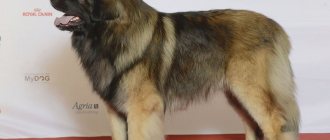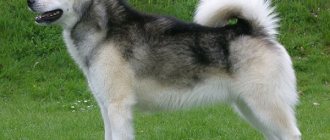Spaniels are a large group of breeds that are primarily hunting dogs, but also include toy and toy dogs.
Among them, the most popular are Cocker Spaniels, Russian Spaniels, Cavalier King Charles Spaniels, Continental Toy Spaniels and others.
The German Wachtelhund, also called the German Spaniel or the German Quail Dog, is a medium-sized hunting dog that can not only find, fly and bring game birds to the hunter, but is also an excellent blood trail follower.
It is strong and resilient enough to hold wounded ungulates in place until its owner approaches.
An excellent hunting assistant and reliable companion, the Wachtelhund is distinguished by its exceptional devotion to its owners.
However, despite all its wonderful qualities, it is little popular outside of Germany and is considered rare almost throughout the world.
Origin story and what it looks like in the photo
In the mid-19th century, English gun breed dogs were used for hunting in Germany . But they turned out to be not very good helpers for German hunters, since they could not work both in open areas and in dense forests at the same time.
In addition, due to their narrow specialization, English cops did not know how to work both with a pen and with an animal, and also did not raise their voices while working.
German hunters needed a dog that could successfully track game in a variety of conditions: in the field, forest, on rough terrain, in the mountains.
It was also very important that the dog could work at any time of the year and would not refuse to go into the water for shot game..
To obtain a breed that best met these requirements, the German breeder Frederick Robert began crossing the German Stöberer with various spaniels of English origin in the 1890s.
Initially, it was believed that only black dogs could work independently, while brown dogs, according to hunters of the late 19th and early 20th centuries, were too dependent on the owner.
Modern Wachtelhunds can all work either walking next to the hunter and following his instructions, or completely independently..
Official recognition of the new breed occurred in 1903, and at the same time a national breed club was created in Germany. And in 1910, eleven dogs were selected throughout the country that best met the requirements of the standard.
It is from these dogs, considered ideal in appearance and working qualities, that all modern Wachtelhunds originate.
In the 1960s and 70s, several German Wachtelhunds were brought to the United States, where they proved to be excellent hunters, even targeting American black bears..
But at the same time, German spaniels received official recognition in this country only in 1996.
Description of the breed
The German Wachtelhund is a muscular and robust hunting dog of medium height with fairly long, thick, wavy hair. However, some dogs of this breed have straight and smooth hair.
Externally, representatives of this breed are slightly reminiscent of English springer spaniels, as well as Russian hunting cocker spaniels, but taller than them and somewhat more massive.
Wachtelhunds are famous in Germany as skillful and dexterous hunters, working both with feathers and with animals, but they are rarely kept as pets.
German Spaniels cannot do without the work for which they were once bred . Therefore, breeders extremely rarely sell puppies to people who are not keen on hunting.
Before starting to use a dog for hunting, German hunters and their pets pass special exams, which include checking the work on the scent of a hare, the absence of fear of water and fear of being shot.
History of the German Wachtelhund dog breed
The birthplace of this breed is considered to be Upper Bavaria, where dogs similar to modern German Wachtelhunds have been known since the 16th century. The breed finally took shape in the 19th century, when German cynologists began to engage in its targeted revival. The ideologist and father of the German Wachtelhund is considered to be F. Robertson, from whom, by the way, the dog received the name “quail” (from the German wachtel - quail and hund - dog). The closest relatives of the German Wachtelhund are European and Old English water dogs, as well as cocker spaniels. The breed standard was approved only in 1981. Distributed in Germany and many European countries, as well as in the USA.
Character traits
German spaniels are calm and friendly, they are trusting of their owners and, with proper training, can be quite obedient.
These dogs are not prone to nervous breakdowns or sudden attacks of aggression . True, they may bark at the sight of strangers, but usually because they are glad to see them and thus express their joy in meeting them.
Wachtelhunds are good-natured and sociable; they treat all their owners equally well, regardless of their age.
At the same time, they have enough strength and courage to hunt even large game, they do not hesitate to go into the water to feed the shot game, and, if necessary, they can hold even a wild boar in place until the hunter arrives.
Wachtelhunds are considered smart and quick-witted dogs, they easily learn new skills, but only if the method of encouragement is used in their training.
If you show rudeness in handling a German spaniel or undeservedly offend the pet, the dog may even refuse to hunt with its owner..
Expert opinion
Kozhevin Semyon Kirillovich
Expert dog handler.
“The German Wachtelhund, little known outside of Germany, is an excellent hunting dog that works equally well on both birds and animals. This dog, without much thought, goes into the water after shot game and does not refuse to work on the blood trail. At home, the Wachtelhund behaves calmly and balanced: he is friendly towards people, even strangers, and gets along well with all family members. However, it is not recommended to have such a dog as a pet, since Wachtelhunds are bored without work, and their unrealized hunting instinct will force them to chase birds, cats and other small animals while walking.”
Character
Wachtelhund is a professional hunter. This breed appeared in Germany at the end of the 19th - beginning of the 20th centuries, when ordinary people received the right to hunt and keep a pack of dogs. The ancestors of the Wachtelhund are considered to be German cops. Information about animals similar to them is found in the literature of the 18th century.
At the same time, representatives of the breed work independently; they are not a pack dog. This feature predetermined the development of character.
The Wachtelhund can safely be called one of the best representatives of German cynology. He is incredibly loyal to his owner and feels him subtly. In addition, he is a friendly and open dog. However, it is important to understand that you cannot do without training. If the owner was able to show who is in charge in this pair, there will be no problems with upbringing. Otherwise, the Wachtelhund can be quite capricious, especially if the training process focuses on negative reinforcement. However, today dogs of this breed are rarely kept as companions - even today they have retained the role of real hunters. Therefore, as a rule, huntsmen are involved in their upbringing.
The Wachtelhund treats children favorably, but does not demonstrate much initiative in communication. Although some dogs are quite patient and can play with children for a long time, they usually form strong friendships with older school-aged children.
In relations with its relatives, the Wachtelhund is peaceful and can get along with a calm and quiet neighbor. He is unlikely to tolerate an aggressive and quarrelsome relative. A dog's life with other animals will largely depend on their upbringing and character. If a puppy ends up in a family that already has a cat, they will most likely become friends.
Subscribe to the newsletter and get a discount at the pet store “Lubimchik”
Thanks for subscribing!
Advantages and disadvantages
pros:
- A universal hunting dog that works on both birds and animals, including large ungulates.
- Can hunt at any time of the year and in a wide variety of conditions - in the forest, field, in wetlands, in the mountains.
- It easily learns to work with a new type of game, for example, in the USA and Canada, Wachtelhunds are used to hunt baribal bears.
- Bold, courageous and vicious towards potential prey during the hunt.
- Friendly and calm attitude towards people.
- They are sociable and get along with all family members, including small children.
- Smart and well trained.
- They can adapt to any conditions and are quite unpretentious.
- Unobtrusive: they don’t like to get under their owners’ feet.
Minuses:
- They are not suitable as ordinary companions, as they cannot do without hunting.
- They need quite a lot of physical activity and long walks.
- They feel best in rural areas.
- They can be aggressive towards small animals.
- Does not tolerate rude treatment and undeserved insults.
- A rare breed, which is why it is not always easy to find a suitable puppy.
Pros and cons of the breed
The table shows the characteristic features of the German Wachtelhund, positive and negative. When choosing a breed to keep, you need to weigh the pros and cons:
| + | — |
| Versatile hunting dog | A very active dog that requires active walks |
| Friendly character | The hunting instinct does not allow keeping a dog in a house with other small pets |
| Easily trainable |
Where to buy a puppy
You should buy the dog from a kennel that breeds the breed, or order a pet abroad. The puppy must have all the necessary documents, including a medical certificate. There are not many officially registered German Wachtelhund kennels in Russia. WachtelClub (Moscow) unites Russian lovers of hunting with dogs and offers hunters purebred German spaniels. The price for a puppy varies within 30,000 rubles.
The Wachtelhund is a true hunter's dog, dedicated to its work, persistent and energetic. A pet's life, filled with the excitement of chasing prey, walks in the forest and fields, will be truly happy.
Breed standard
- Head . Proportional to the body, slightly flattened in the skull, with a not too sharp transition to the muzzle.
- Muzzle . Of medium length, tapering only slightly towards the tip of the nose, it looks almost rectangular from the front.
- Ears . Set approximately at eye level, quite long: the tip of the extended ear should reach the nose.
- Eyes . Small, slightly slanted, with an expressive and calm look.
- Neck . Strong and muscular.
- Rib cage . Round in shape, with slightly curved ribs.
- Belly . Moderately tucked, not forming a strong bend.
- Forelegs . Parallel, quite strong and even.
- Hind limbs . Strong, with muscular thighs and well defined joint angles.
- Tail . Thick at the base and strong, not rising above the line of the back.
- Wool . Thick, wavy, close-lying with well-developed undercoat. It is short on the head, muzzle and front side of the legs, medium length on the body, and has small feathering on the ears, lower part of the tail and back of the limbs.
Among hunters, it is traditional to dock the tails of German Wachtelhunds by about 1/3 of the length, as this makes it easier for the dog to work in the thickets of the forest and reduces the risk of injury.
German Wachtelhund: description of the breed
The German Wachtelhund is a strong, muscular and robust medium-sized hunting dog with a fairly long, thick, silky coat. Externally, the pets of this breed are somewhat reminiscent of English springer spaniels, as well as Russian hunting cocker spaniels, but they are more massive and slightly taller.
According to the standard, Wachtelhunds look like this:
- Body build: compact, well-fed, elongated. The chest is oval, strong, the back is straight.
- Dimensions: the height of males at the withers is 48-54 cm, females 45-52 cm; the weight of females is 18-25 kg, males 23-30 kg.
- Head: rounded, slightly flat, with a long muzzle, the transition from forehead to muzzle is smooth.
- Eyes: medium size, oval, slightly slanted, brown or light brown in color.
- Nose: large, with wide nostrils, dark in color.
- Ears: set high, wide, rectangular, covered with long hair.
- Tail: long, docked, in a calm state it is at the level of the back or lowered.
- Limbs: straight, parallel, muscular, paw pads wide and elastic.
- Coat: medium length, thick, slightly wavy, with a dense, dense undercoat.
- Color: pure brown or red with white markings on the chest and legs, white with brown markings or spots.
Color variations
The most typical color for German Spaniels is brown or reddish, often with small white markings on the chest and toes..
A brown or red-mottled coat color is also acceptable for them. In addition, there are white dogs with brown spots or brown spots.
NOTE!
The black color is currently considered non-standard and is not found in purebred Wachtelhunds.
Any standard color may have a tan.
Exterior of a German Wachtelhund Spaniel
This dog is similar to a small German Longhaired Pointer, only more squat and somewhat stretched out. This structure is very practical. In order for the dog to be able to maintain balance when feeding heavy hares or foxes, it needs a certain length and massiveness of the body despite its short stature.
The exterior of the German Wachtelhund Spaniel must meet the following parameters: height at the withers for males 48-54 cm, for females - 45-51 cm, weight about 20 kg, regardless of gender.
No more than two colors are bred: dark brown, different shades of brown with small white spots on the chest and toes.
Pay attention to the photo of the Wachtelhund: with the main color being brown, there may be red tan marks. Black-brown and spotted dogs with a white background, brown spots, saddle and specks are rejected.
Is he good with children and does he get along with other pets?
The German Wachtelhund gets along well with children, even the smallest ones, and willingly plays outdoor games with older ones.
German spaniels are quite friendly towards other dogs and rarely conflict with them..
But at the same time, German spaniels do not tolerate the presence of smaller animals - cats, ferrets, rodents and birds.
Due to their highly developed hunting instincts, Wachtelhunds will regard such pets as their potential prey and may hunt them.
Spaniel Club. All about spaniels.
The German Wachtelhound, also called the German spaniel or quail hound, has earned the reputation of being an unsurpassed hunter of game birds. They are distinguished by a very friendly and affectionate disposition, but due to their strong hunting instinct, they are rarely kept as pets. Even in their homeland in Germany they are not widespread. These dogs are real hunters, constantly in need of movement and fresh air, and such a need is difficult to satisfy in urban conditions. To keep your Wachtelhunds in working shape and in good health, you need to take them for long walks and exercise every day. That is why foresters and professional hunters often prefer to keep such dogs.
The appearance of the German Wachtelhund is characteristic - it is a small dog with a somewhat elongated and squat body. She has a strong build, dense bones, a deep chest, a beautiful head and an elongated muzzle. At the withers, an adult male can reach 48-54 cm, and an adult female - 45-51 cm. A normal weight is considered to be about 20 kg.
Wachtelhund (German Spaniel). Breed description and standard
The Wachtelhund is covered with fairly long, thick, wavy and close-lying hair. There are featherings on the paws and neck, and a dewlap on the tail. According to the standard, the color of the German Wachtelhund can be of two varieties: brown (with the possible inclusion of all shades of red) and brown-piebald (that is, with the “dilution” of brown with white hair). In both cases, there may be speckling and white markings on the toes and chest. By the way, the breed standard was approved only in 1981, although these German spaniels have been bred as a pure breed since 1897.
The German Wachtelhund has a specific name - quail hound. However, despite its exclusively avian specialization, it can be safely called a universal hunting dog. He is an exceptional professional in his field. But at the same time, the German Wachtelhund is also a completely domestic family dog, selflessly devoted to its owner. She is absolutely non-aggressive towards humans, so she is perfect for keeping in the house. The only problem is the need for regular and active movement. Of course, it is best to keep such a dog in a house that is located in the forest, and whose owner has work for his pet every day.
We invite you to watch a video about the Wachtelhund (German spaniel). Breed description and standard...
How to properly care
The German Spaniel's coat should be brushed approximately once a week and washed as needed using dog shampoo.
It is recommended to inspect the ears and eyes every day and clean them if dirty . Teeth should be brushed periodically, about twice a month, with a toothbrush and toothpaste intended for dogs.
Nails are trimmed as they grow, but care must be taken not to injure the pet during this procedure.
It is advisable to periodically trim the hair between the toes and paw pads, as otherwise it will collect dirt, and in winter ice will freeze on it, causing discomfort and even pain to the pet..
Maintenance, care and health
Since the German Spaniel is a hunting breed, the best place to keep it would be a country house. The dog needs a lot of free space, long walks, training and physical activity. Only in such conditions will the pet be healthy and happy.
It is not difficult to care for representatives of the breed; it is enough to carry out the following hygiene procedures:
- Brush long, thick fur once a week with a special brush. During the shedding period, the coat needs to be combed every 2 days.
- Keep your eyes, ears and teeth clean.
- Cut off claws.
Your pet's floppy ears require special attention. They are heavy and block the passage; without proper hygiene, infections and otitis media can develop inside the ears. Also, dogs of this breed often suffer from the following ailments:
- hip dysplasia;
- eye inflammation;
- hypothyroidism;
- volvulus;
- melanoma;
- epilepsy;
- allergy;
- skin diseases.
With timely prevention and contacting a veterinarian, the occurrence of the above diseases can be avoided.
How long do they live? Health and major diseases
German Wachtelhunds live from 12 to 15 years.
The breed is generally considered to be quite prosperous and healthy, however, some of its representatives may be predisposed to the following health problems:
- Skin diseases such as dermatitis or eczema.
- Oral diseases that are more common in animals with malocclusions.
- Dysplasia. Retinal atrophy.
- Eversion and inversion of the eyelids.
- Hypothyroidism.
- Allergies.
- Melanoma.
- Degeneration of intervertebral discs.
- Epilepsy.
Nutritional features - what is best to feed?
Like all hunting dogs, the German Wachtelhund needs nutritious, complete food rich in protein.
With natural feeding, approximately 2/3 of the diet should be lean muscle meat and offal with the exception of bones, kidneys and raw liver.
To them you should add a little porridge made from oatmeal, rice or buckwheat, as well as boiled or raw vegetables. Fermented milk products - cottage cheese, kefir and natural low-fat yogurt - are useful, especially for growing puppies.
Once a week, it is recommended to replace meat with boiled sea fish without bones, and you should give one and a half times more fish than meat..
The German Spaniel is also suitable for feeding with a premium quality complete food or higher. It is very important to choose the right brand according to the size, age and physical condition of the pet.
For a dog suffering from a disease that requires food restrictions, special dietary foods are best suited.
Maintenance and care
As mentioned above, the Wachtelhund is not suitable for keeping in an apartment; it is a hunting dog that needs regular training and walks. For health and beauty, the dog's coat should be brushed with a thick brush. Ears and eyes are washed as needed with clean water or special wipes. You need to feed your Wachtelhund high-quality meat food made from natural ingredients. Feeding food from the table is permissible only in minimal quantities as a treat (crackers, cheese, etc.).
How to choose?
In order for a puppy to grow into a typical representative of its breed and become a good hunting assistant, you need not to rush into acquiring it, but to approach the choice of your future pet responsibly.
CAREFULLY!
It is not recommended to buy a German spaniel without documents, since there is no guarantee that the purchased baby will not be a mixed breed or will not suffer from any disease.
When choosing a puppy, you need to take into account that males are more active and look more impressive in appearance, but at the same time they can be more stubborn than females.
Female Wachtelhunds are more obedient and good-natured, they get along better with children, but you cannot hunt with them during heat, which may not be very convenient.
A purebred German spaniel puppy looks quite strong and well-fed, it has fairly thick paws, a rectangular muzzle and elongated wide ears covered with silky wavy hair.
The baby’s gaze should be friendly, calm and attentive, and both cowardice and aggression are completely unacceptable in his behavior.
Main nurseries in Russia and the CIS
In Russia, it is recommended to purchase a dog of this breed through the National Breed Club “German Wachtelhund”, which is located in Moscow.
In Ukraine, you can buy a German spaniel in the MASTER HUNTING kennel in Kirovograd.
Data on these organizations can be found on the Internet or on their websites.

